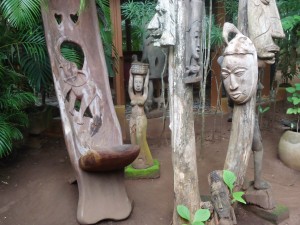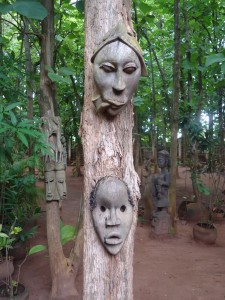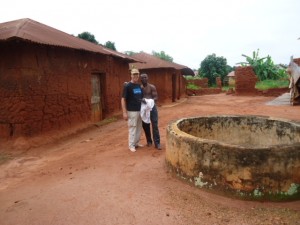Abomey has many, many palaces in varying stages of decay or reconstruction , the main palace is a walled area 14 hectares in area.   We hired a guide out of Chez Monique for two hours in the morning to show us things other than the museum in the main palace because the admission includes a guide. Two hours is not very much time but he took us to an older, quasi-restored palace on the outskirts of town. Here one could see some of the same structures that had been present in the Palace of Tofa I.  The element that this visit most drove home to us was again the link between the past and present.  In this case it came in the form of the respect which the guide showed for the king that had been dead for 4 centuries.   It is traditional that anyone visiting the king visiting room has to take off his shirt, partly as a sign of respect and partly to show he has no concealed weapons. They excuse tourists from this requirement, but any Beninois to this day takes their shirt off when they go in. Our guide was not the only one to do this.
The visit to the palace was not an altogether positive experience. Â The site included a cage for two sick looking lions and a pretty disgusting pit where they kept a pitiful-looking crocodile.
Afterward we took our guide for a slow lunch that took up any time we might have to spare for the museum before we had to leave for our next Dassa, the next destination in our journey north.  Dassa is only a stopover on a long journey to Nattitingou, which holds both enthnocultural (the Tatasomba houses) and natural (Parc national Pendjari). After numerous unsuccessful visits to ATMs and filling stations we were able to get some CFA (French West Africa francs) and some diesel before we headed north out of town.   The bank that worked for us was the Bank of Africa, which we have not used before but seems to have many branches so we can relax a bit about cash flow. We are actually not spending very much money at all: diesel is cheap, our accommodations are not expensive even when we go to a hotel, and we make most of our own meals. Guides and souvenirs are likely to be among the greatest expenditure we have.



